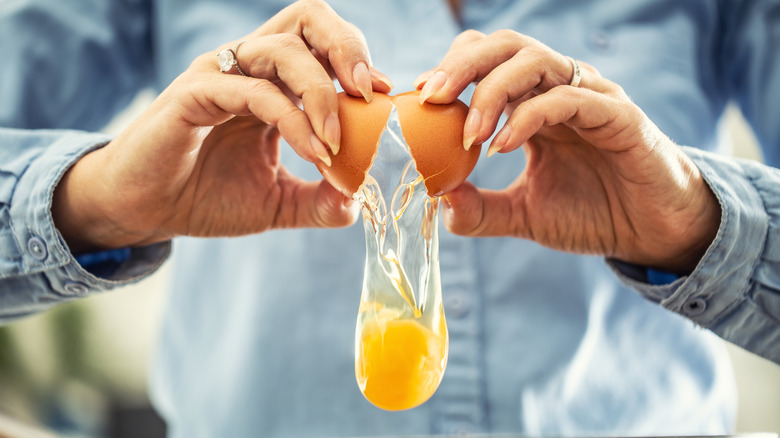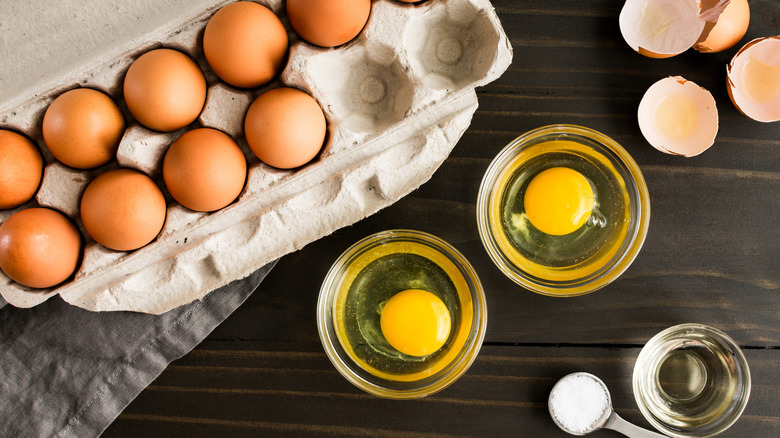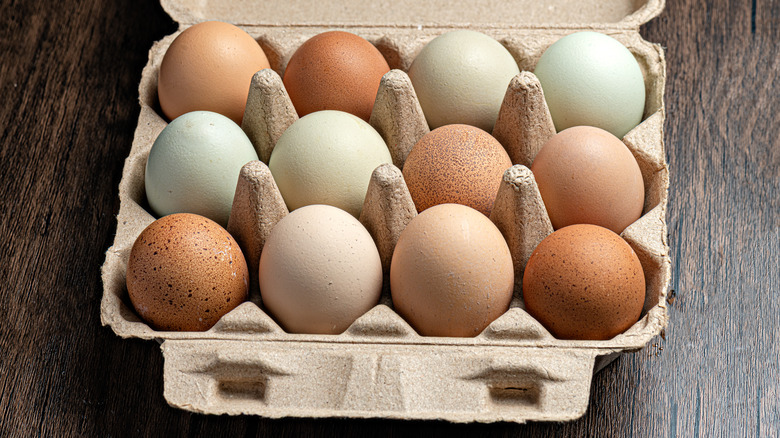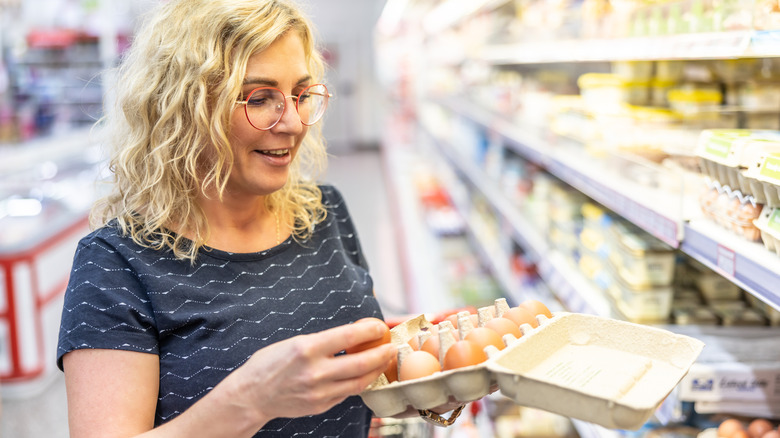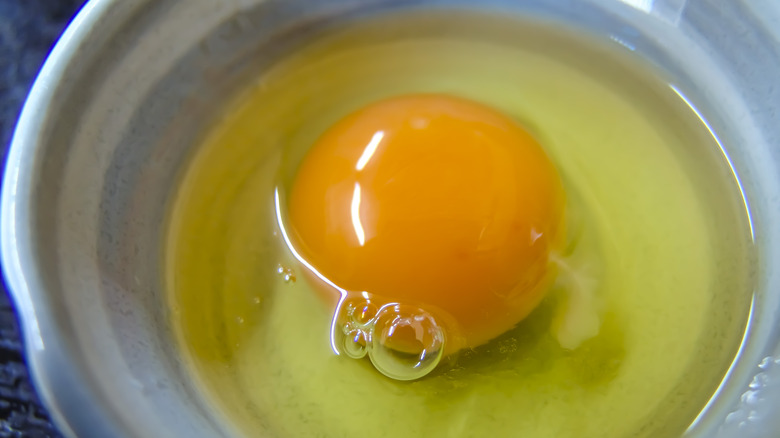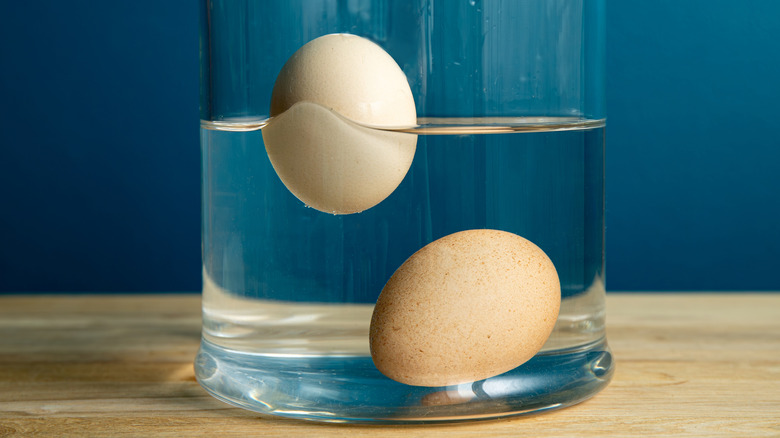4 Proven Ways To Check If An Egg Is Bad (And 5 Myths To Ignore)
Eggs are one of the best proteins we humans have on the menu. You can eat them morning, noon, and night, and you can cook them in almost any way you can imagine. But, of course, eggs aren't perfect. There are plenty of unhealthy ways to cook eggs, and it can sometimes be difficult to tell if eggs are good or not. We'd say that a raw egg is an enigma wrapped in mystery, but honestly, we don't need to dress it up in fancy language. Those shells simply don't tell us much on their own — unless the eggshells are cracked, in which case, get them out of the carton.
You have to rely on centuries of human knowledge to know about the shelf life of an egg. Don't have centuries of human knowledge queued up? Don't worry, that's what we're here for. Can you really tell if an egg is fresh by shaking it? Is the float test accurate? Should your eggs, you know, smell like that? We're here to separate fact from fiction, and hopefully help you avoid unpleasant egg experiences (say that five times fast) in the future.
Fact: Cracking the egg (sniff test)
Take this entry and apply it to all of the other ones. Once the egg's out of the shell, that's when you can really tell what's going on, in terms of freshness. The biggest telltale sign that an egg has gone off is the smell. It's a pungent, sulfurous smell, and it makes the air in a room feel sickening. There's a reason people compare anything unpleasant to the smell of rotten eggs. Crack your egg, and if it's bad, it will emphatically let your nose know.
That sulfur smell signals a lot of health risks. Going bad doesn't mean that your eggs started wearing leather jackets and smoking cigarettes under the bleachers. Going bad means that your eggs have developed harmful bacteria like E. coli. If you ignore that smell and chow down on your morning meal of a scrambled egg sandwich dressed with freshly made mayo? Within six to 48 hours, expect to feel some tummy rumblings at best. Fever, vomiting, and diarrhea will be on your to-do list for the next four to seven days. If that doesn't sound like a fun way to spend your week, remember that raw eggs should have no smell.
Myth: Shaking the egg
Here's one that gets passed down through the generations: The shake test. The reality of the shake test is not quite as straightforward as you might think. It is true that if you hold an egg to your ear, shake it, and hear nothing, then the egg is fresh. If you hear any kind of sloshing, what that means is that the egg is old.
Eggs are like all of us, getting older every day. The sloshing of an old egg doesn't necessarily mean it's bad. It just means the yolk has absorbed so much moisture from the white that it might be a little misshapen. In all likelihood, you can still use these eggs in baking, or even scrambling. In fact, week-old eggs make for the easiest egg salad, because that extra air makes boiled shells easier to crack.
That said, a sloshing egg can still be bad! Getting older is the first step in a food item's journey to becoming inedible. All we're saying is that the shake test doesn't give you a green or red light by itself. You should keep your eyes and nose on alert to inspect the egg after it's been cracked.
Fact: Cracking the egg (visual cues)
There are lots of ways to look at a cracked egg and know when something's wrong. If the egg is completely jumbled, with white and yolk clumping around each other and sticking to the shell? That's no good. If you see green or black spots in the egg, that could signal a fungal contamination. An off-color or green tint in the egg white obviously means the egg is bad. Maybe you've heard that over-boiling eggs can lead to a green ring around the yolk? That's because sulfur and iron compounds — which naturally occur in eggs — have started reacting during cooking. Now, some green in a hard-cooked or hard-boiled egg is safe to eat. Having some green in the egg while it's still raw? Avoid that at all costs.
It is true that most eggs will not have that perfectly oval white and yellow that you might see in cartoons. Some visual oddities are harmless. A cloudy egg white, for instance, means the egg is very fresh. A little red spot just means a blood vessel in the yolk ruptured at the time of ovulation — no harm to the hen, no harm to you. Speaking of the hen, your egg yolk's color is largely influenced by what hens eat. A yolk that's more yellow or more orange (or even a yolk that's white or clear) is not a freshness indicator.
Myth: Shell texture can mean a bad egg
It's a reasonable enough assumption: If there's something off about outside texture or appearance, then there's something off about the inside. That's not the case with eggs. Shell texture doesn't determine freshness. If you pull an egg that's spotty or bumpy out of the carton? No problem, scramble away. Often, all a rough shell means is double ovulation. In these cases, a hen will lay an egg without a shell, followed by another with extra bits of calcium carbonate — aka extra shell deposits. If you happen to have a chicken coop in your yard and your birds start laying eggs with rough shells? Don't worry, this issue usually only affects about 1% of production.
Of course, roughness isn't the only issue that affects shells. What about if a shell is cracked? First, never buy a carton with a cracked egg. If an egg cracks on your way home from the grocery store, though? All you need to do is break those eggs into a different container, tightly seal and refrigerate it, and cook them within two days. You're going to want to cook those eggs all the way through, though — firm whites and yolks here.
Fact: Checking the Julian date on the carton
The Julian date on a carton of eggs tells you when the eggs were packed. So long as the eggs are kept under 45 degrees Fahrenheit, they can be eaten for four or five weeks after the Julian date. As the consumer, you should pay far more attention to the Julian date than the expiration or sell-by date. The latter kind is for the grocery store, not you. The Julian date, on the other hand, is like if a salmon filet came stamped with the exact date a fisher caught the salmon. Or if fruit packaging came with a picture of a farm worker picking an orange from a tree while holding a copy of that day's newspaper. The Julian date on an egg carton is a real gift to consumers, and a good reason to hang on to your cartons.
How can you tell the difference between the Julian date and the sell-by or expiration date? It's kind of fun, actually: The Julian date will be a number between 001 and 365, aka January 1 through December 31. If the date reads 031, you know those eggs were packed on January 31. 032? That's February 1. See? Fun, like a code that James Bond would have to memorize. The Julian date is often stamped right underneath the sell-by or expiration date.
Myth: Checking the expiration date on the carton
If a product's packaging says that it's best by a certain date, it's understandable for a consumer to assume that the date applies to them. This is not the reality. "Sell-by" and "use-by" dates are really only used to measure predicted quality. Hey, it's not just consumers who need to know how old eggs are. Store workers need to be on top of their inventory. No supermarket wants to sell eggs that won't stay optimal for as long as can reasonably be expected — or, in the worst case scenario, accidentally sell an already bad batch.
Is there a difference between "sell-by" and "use-by?" Turns out, yes. Sell-by is not about safety. The sell-by date is there to help the grocery store with inventory management — a number for the stockers and whoever orders new products. Use-by, on the other hand, is directed at consumers. For eggs, though, use-by is still not a safety date. The use-by date simply tells you when your eggs are no longer at peak quality.
Fact: Ensuring proper home storage
Eggs need to be kept below 45 F at all times. Do that, and the dozen of them will stay fresh for as long as possible. Of course, sometimes you need room temperature eggs — these don't crack as much during boiling, and they're often better for baking. This is fine, but just be careful and pay attention. Whether you need them at room temperature for a recipe or you just plum forgot to put the carton in the icebox, if you do leave a carton of eggs out, you have a two-hour window before they start to spoil.
If your refrigerator has one of those cute door inserts that conveniently hold a dozen eggs, many safety experts actually recommend not using it. For one thing, taking the eggs out of the carton usually means tossing that carton in the recycling, and then how will you check the Julian date? For another, the fridge door opening and closing all the time means that the temperature in that part of the fridge fluctuates more than anywhere else. Have you ever had your body thrown out of whack because fall was changing to winter or winter to spring? Eggs don't like dealing with that, either. Keep your eggs stored at the proper temperature, keep an eye on that Julian date, and use your nose before you cook. If you do all this, there should be no worries at breakfast time.
Myth: Big air pockets indicate a bad egg
Air pockets are perfectly natural in eggs. Sure, cracking a boiled egg and seeing a big gap at the top is a bummer, but that's just how it goes sometimes. You didn't accidentally boil a bad egg. Since shells are porous, the liquid inside is going to slowly evaporate over a course of weeks and months, and bigger air pockets are the natural result. By itself, a big air pocket does not mean a rotten egg.
If you've ever wondered what the grade on a carton of eggs means, it has a lot to do with the size of air pockets. All eggs start out as grade AA, meaning they have the smallest air pockets. Grade A has a slightly bigger air pocket, and grade B has the biggest. It's true that if you want the best eggs, you should look at the grade label. That doesn't mean grade A eggs are any less desirable than AA. What makes an egg downgrade from AA to A to B? Time. That's why grade A is what's most often on grocery store shelves. Because grade AA eggs are ludicrously fresh, they're the absolute top tier you can get. While that's great, you genuinely don't need to eat like that all the time. Grade A eggs are great scrambled, fried, baked, and poached. So don't worry too much about air pockets.
Myth: The float test
That's right, not even the famous float test is 100% accurate. It's true that the freshest eggs will sink to the bottom and lay on their sides, slightly older eggs will sink but stand upright, and old eggs will float to the top, but that doesn't necessarily mean those eggs are bad. It's recommended that you use those older eggs for hard boiling. Even after boiling, though, you should keep your wits about you. If you do the float test, decide to boil a floating egg, and then crack that boiled egg and it smells off? Chances are, it's a bad egg.
Some people even prefer using old egg whites when making meringue. Older whites have an easier time foaming, so they make a greater volume, meaning it's faster and takes less effort than using fresh eggs. The same is true of room temperature eggs, with the only downside that the meringue is much less stable than it is when cold, fresh eggs are used. If you're not eating that lemon meringue pie right away, it's probably best to use eggs that sink. If, however, you find yourself on the morning of a potluck with a carton full of floaty eggs? That's actually a dream scenario. Whip up a quick dessert.

